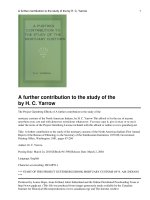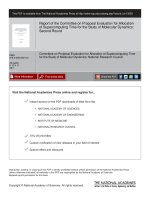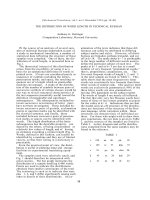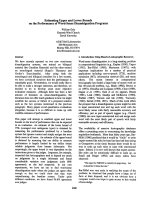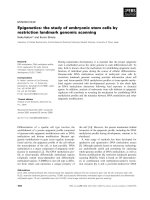MORPHOLOGY THE STUDY OF WORD FORMATION
Bạn đang xem bản rút gọn của tài liệu. Xem và tải ngay bản đầy đủ của tài liệu tại đây (43.5 KB, 3 trang )
5. Each of the following columns illustrates a different morphological process.
Column 1
Column 2
a. mouse/mice
f. récord/ recórd
b. dive/dove
g. ímport/impórt
c. take/took
h. cónvict/convíct
d. goose/geese
i. ímprint/imprínt
e. eat/ate
j. óutrage/outráge
i. What morphology process is at work in column 1? Column 2?
In column 1 and column 2, it’s CONVERSION
ii. Describe in your own words the difference between the process exemplified in column 1
versus that in column 2
In column 1, a type of conversion is ablaut, which is the replacement of a vowel with a
different vowel. It is used in forming new words (replace form of verb, noun)
In column 2, another type is stress shift. It is used in inventing a new word by shifting the place
of stress, to mark the difference between related nouns and verbs
iii. Think of at least one more English example to add to each column.
Example:
Column 1
Column 2
knife/knives
cóntest/contést
man/men
cóntrast/contrást
sing/song
cónvert/convért
6. The following words can be either nouns or verbs
a. record
f. outline
k. report
b. journey
g. convict
l. outrage
c. exchange
h. imprint
m. answer
d. remark
i. reprint
n. import
e. surprise
j. retreat
o. cripple
i. For each word, determine whether stress placement can be used to make the distinction
between noun and verb
f. récord (n) / recórd (v)
ímport (n) /impórt (v)
cónvict (n) /convíct (v)
ímprint (n) /imprínt (v)
óutrage (n) /outráge (v)
ii. Think of two more English examples illustrating the process of stress shift to mark a category
distinction
Example:
prótest (n) / protést (v)
récall (n) / recáll (v)
7. The following Samoan data illustrates one of the morphological processes discussed in
this chapter
a. [mate]
‘he dies’
[mamate]
‘they die’
b. [nofo]
‘he stays’
[nonofo]
‘they stay’
c. [galue]
‘he works’
[galulue]
‘they work’
d. [tanu]
‘he burries’
[tatanu]
‘they bury’
e. [alofa]
‘he loves’
[alolofa]
‘they love’
f. [taoto]
‘he lies’
[taooto]
‘they lie’
g. [atama’i]
‘he is intelligent’
[atamama’i]
‘they are intelligent’
i. What morphological process is illustrated by these data?
It’s REDUPLICATIVE AFFIX
ii. Describe how this process works
The duplicative affix is a copy of the first consonant, vowel-sequence of the root.
iii. If ‘he is strong’ in Samoan is malosi, how would you say ‘they are strong’ in Samoan?
It’s [malosisi’i]
8. The following data from Agta (spoken in the Philippines) illustrates a specific type of
affix.
a. [dakal]
‘big’
[dumakal]
‘grow big, grow up’
b. [darág]
‘red’
[damarág]
‘redden’
c. [furáw]
‘white’
[fumaráw]
‘become white’
i. What is the affix in Agta meaning ‘become X’?
[furáw]
ii. What type of affix is it?
It’s INFIX
iii. Describe its placement.
INFIXES are inserted within words, e.g. the infix –um– in Tagalog, which shows that a verb
is in the past tense: sulat (to write) sumulat (wrote).


